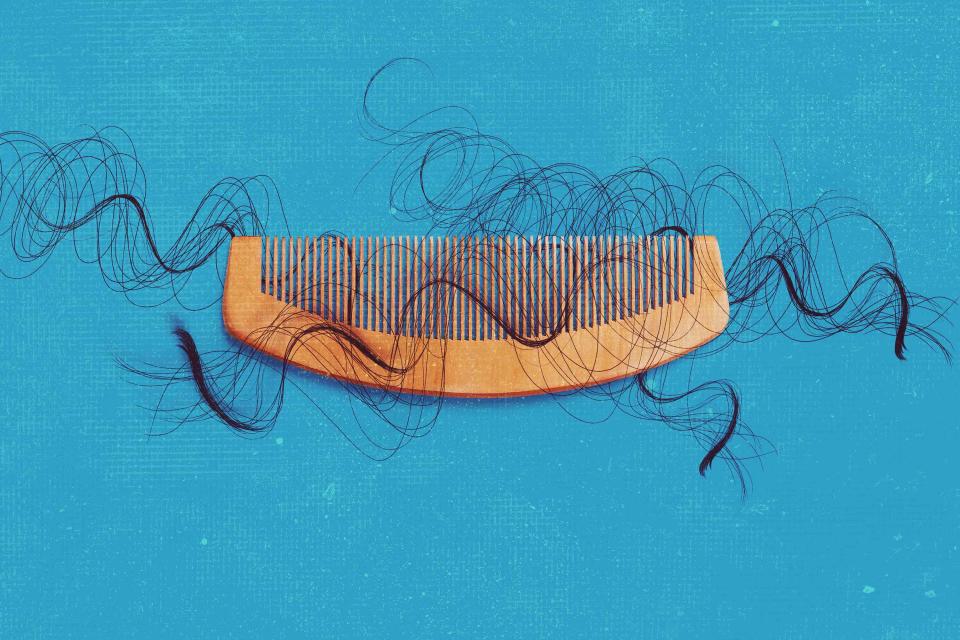Seasonal Hair Loss Is a Thing—Here’s What You Can Do to Combat It
Experts weigh in on the weather-hair loss connection.

Carol Yepes/Getty Images
The changing of the seasons beckons many new changes—some of them less favorable than others. If you notice more hair than usual on your pillow, in the shower drain, or wedged between your hairbrush specifically timed to when the weather changes, you may be experiencing perhaps one of the worst seasonal occurrences: seasonal hair loss.
But don’t stress! The good thing about seasonal hair loss is that it’s seasonal (read: temporary). But since that doesn’t make hair loss any less distressing, we spoke to expert hairstylists and trichologists on how to deal with it while it lasts.
What is seasonal hair loss?
People naturally lose about 100 strands of hair a day, but those with seasonal hair loss often experience a sudden and consistent change in the amount of hair shed without any illness or trauma to explain it. (It's not to be confused with telogen effluvium, which is primarily caused by stress.) “Seasonal hair loss is when your scalp becomes stressed from the change in temperature leading to a loss in hair,” says Wes Sharpton, hairstylist and Lead Brand Educator for Hairstory. “Fall and spring are typical times for seasonal hair loss to occur.”
To understand why this happens, it’s important to know that our hair goes through multiple cycles. “Our hair has four main growth cycles: anagen (the growth phase), catagen (the transition phase where hair starts to release), and telogen (the resting phase), and exogen (when the hair sheds),” says Britt Dion, stylist and artistic director of Aveda. According to a 2009 study by Swiss researchers, our hair tends to rest in the telogen phase in summer and enter the exogen phase (or the shedding phase) in fall—and occasionally spring.
Although more research is needed to determine the root cause behind this transition, there is something about temperature changes which triggers the scalp and follicles to enter a shedding phase.
How to Treat Seasonal Hair Loss
Like any type of hair loss, scalp heath is number one in reversing it. Since a dry scalp can cause more hair loss, it’s a good idea to incorporate a deep conditioning treatment (i.e. mask) to your scalp at least once a week when the seasons change. A hot oil treatment using oils known to stimulate hair growth (green tea oil, castor oil, geranium oil) can make a huge difference. Dion also recommends adding a good clarifying shampoo into your routine to help remove dirt and oil from your cuticles while stimulating your follicles.
Eating a well-balanced diet will also help reduce the amount of shedding. “Keeping key hair growth nutrients at the optimum trichological ranges can help prevent seasonal hair loss,” says William Gaunitz, FWTS, certified trichologist and founder of Advanced Trichology. “Those nutrients are vitamin D3, ferritin, iron, zinc, B12, and folate. Lack of these vitamins can increase hair loss, as well as inflammation from seasonal allergies, increased sugar intake, and limited sun exposure.” In other words, loading up on anti-inflammatory superfoods and taking additional supplements could help during this time.
And lastly, try cutting back on heat styling, tight hairstyles, and harsh hair dyes leading up to the transitional months to reduce your chances of developing seasonal hair loss and prevent any scalp irritation.
Ultimately, remember that seasonal hair loss is completely normal and nothing to dwell upon—it’s seasonal, after all. If you are experiencing excessive shedding that expands beyond the changing seasons, schedule an appointment with a trichologist to get to the root of the issue.
For more Real Simple news, make sure to sign up for our newsletter!
Read the original article on Real Simple.

 Yahoo Autos
Yahoo Autos 